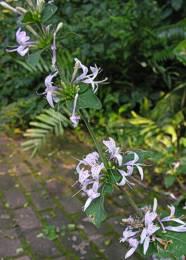Hypoestes aristata
Hypoestes aristata (Vahl) Sol. ex Roem. & Schult.
Family: Acanthaceae
Common names: ribbon bush (Eng.); seeroogblommetjie (Afr.); uhladlwana olukhulu, uhlonyane, uhlalwane (Zulu)
Introduction
The ribbon bush with its attractive lilac pink flowers is an excellent garden subject.

Description
Description
Hypoestes aristata is a fast-growing shrub that grows up to 1.5 m high. It produces soft, hairy, dark green oval leaves and has attractive lilac pink or white flowers borne in spike-like inflorescences. It flowers from May right through winter till early spring.

Distribution and habitat
Distribution description
It is usually found in dry thicket, forest and damp places from the Eastern Cape in the south to tropical Africa in the north.
Derivation of name and historical aspects
History
The word hypo in Greek means "under" and estia means "a house"- referring to the way the bracts cover the calyx.
Ecology
Ecology
Bees, flies and other small insects visit the flowers in search of nectar or pollen, thus becoming a food source for insectivorous birds, like Puffback (Dryoscopus cubla), Southern Boubou (Laniarius ferrugineus), barbets, robins and thrushes.
Uses
Use
Ribbon bush is eaten as spinach in some areas, while traditionally crushed leaves are used as a poultice for sore eyes. It also makes a good cut flower because it lasts well in water.

Growing Hypoestes aristata
Grow
The ribbon bush can be propagated from both seeds and cuttings. When seeds are sown in August they will germinate in three weeks. It also tends to seed itself in the garden. You can collect a handful of seeds and sow them in containers or plastic bags until they are large enough to be planted directly in the garden. Ribbon bush should be watered well in summer but less in winter and it needs to be pruned back after flowering. It requires very little attention because it grows easily in the garden.
References
- Cavendish, M.. Encyclopedia of gardening, vol. 3.
- Eliovson, S. 1955. South African wild flowers for the garden. Cape Town.
- Joffe, P. 2001. Creative gardening with indigenous plants. Briza, Pretoria.
- Kruger, T.J.1973. Trees, shrubs and climbers, Bethal.
- Pooley, E.2006. Forest plants in the forest and in the garden, Durban
Credits
Patrick Mtsweni
Lowveld National Botanical Garden
March 2010
Plant Attributes:
Plant Type: Shrub
SA Distribution: Eastern Cape, KwaZulu-Natal, Mpumalanga
Soil type: Sandy, Loam
Flowering season: Late Summer, Autumn, Winter
PH: Acid, Alkaline, Neutral
Flower colour: White, Mauve/Lilac
Aspect: Full Sun, Shade, Morning Sun (Semi Shade), Afternoon Sun (Semi Shade)
Gardening skill: Easy
Special Features:
Horticultural zones











Rate this article
Article well written and informative
Rate this plant
Is this an interesting plant?
User Comments
Barker , South Africa
May 17, 2020 at 3:23 PMHardy, rewarding and good focal plant.
Liz Runciman, Australia
October 18, 2021 at 9:26 AMGrows very easily from cuttings
Login to add your Comment
Back to topNot registered yet? Click here to register.